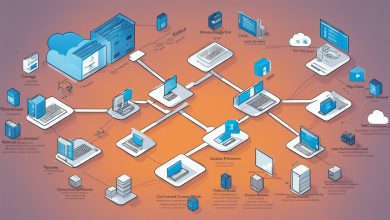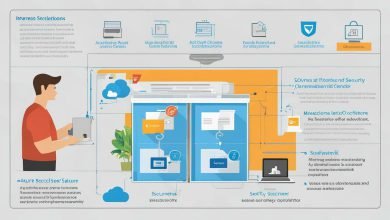
In today’s digital age, businesses rely heavily on technology to streamline their processes and deliver value to their customers. However, with different systems and applications in place, integrating them to work seamlessly together becomes a challenge. This is where system interoperability comes into play, enabling various systems to communicate and share data with each other.
System interoperability solutions are critical for businesses looking to unlock their full potential. By integrating their systems, businesses can improve collaboration, increase efficiency, and boost productivity. System interoperability can also help businesses provide better customer experiences and drive innovation.
Key Takeaways
- System interoperability enables different systems to communicate and share data with each other.
- Interoperability solutions are critical for improving collaboration, efficiency, and productivity in businesses.
- System interoperability can help businesses provide better customer experiences and drive innovation.
Understanding System Interoperability
System interoperability refers to the ability of different systems to communicate and exchange data seamlessly. This is made possible through the use of interoperability standards and frameworks, which provide a common language and set of protocols for different systems to interact.
Interoperability standards are specifications that define how systems should interact with each other. These standards can include protocols for data exchange, communication interfaces, and data formatting, among others.
Interoperability frameworks, on the other hand, are sets of tools, guidelines, and resources that help in implementing interoperability standards. These frameworks provide a structured approach to achieving system interoperability by defining how different systems can be integrated and how data can be exchanged.
Why Interoperability Standards and Frameworks are Important
Interoperability standards and frameworks are essential for enabling seamless communication between different systems. Without these standards and frameworks, integrating disparate systems can be a complex and time-consuming process, and data exchange can be error-prone and inefficient.
By using interoperability standards and frameworks, businesses can streamline their processes, improve collaboration among different departments, and enhance productivity. These tools also provide a basis for scalability, allowing businesses to easily integrate new systems and technologies as they grow.
| Benefits of Interoperability Standards and Frameworks |
|---|
| Improved data accuracy and consistency |
| Streamlined processes and workflows |
| Enhanced collaboration and communication |
| Increased efficiency and productivity |
Interoperability standards and frameworks are essential for unlocking the full potential of different systems and technologies in businesses. By providing a common language and set of protocols, these tools enable seamless communication and data exchange, leading to improved collaboration, efficiency, and productivity.
Benefits of System Interoperability
The benefits of system interoperability are vast and essential for businesses looking to achieve their full potential. By seamlessly integrating different technologies and systems, businesses can improve collaboration, efficiency, and productivity, among other advantages.
Improved Collaboration
System interoperability enables teams to collaborate more effectively and efficiently. By breaking down technological barriers, teams can communicate and share data seamlessly, which leads to greater collaboration and improved results. Additionally, teams can use a range of systems and technologies to collaborate, which makes it easier to work remotely or across different locations or departments.
Increased Efficiency
Interoperability solutions streamline processes, making them more efficient. With system interoperability, businesses can integrate different technologies and systems, reducing the need for manual data entry and other repetitive tasks. This automation frees up time and resources, allowing businesses to focus on more critical tasks and improve overall efficiency.
Enhanced Productivity
System interoperability enables businesses to leverage their data to make more informed decisions and take actions faster. By having access to real-time data from multiple systems and technologies, businesses can quickly generate insights and take action, leading to enhanced productivity. This also allows businesses to better understand their customers and their needs, which can lead to improved customer experiences.
Reduced Costs
Interoperability solutions can also help businesses reduce costs. By integrating different technologies and systems, businesses can reduce the need for expensive custom solutions and reduce the costs of maintaining separate systems. Additionally, system interoperability can help businesses avoid data errors and other technical issues that can result in costly downtime or other issues.
In conclusion, system interoperability is essential for businesses looking to unlock their full potential. The benefits of interoperability solutions are clear, including improved collaboration, increased efficiency, enhanced productivity, and reduced costs. Therefore, it is crucial for businesses to prioritize interoperability when developing their technology and data strategies.
Challenges in Achieving Interoperability
Despite its numerous benefits, achieving system interoperability is not without its challenges. Here are some common interoperability challenges:
| Interoperability Challenges |
|---|
| Incompatible Technologies: Different systems may rely on different technologies, making it difficult for them to communicate and share data seamlessly. |
| Data Integration Issues: Integrating data from different systems can be complex and time-consuming, often requiring manual intervention to ensure accuracy and consistency. |
| Resistance to Change: Some stakeholders may resist changes to their existing systems or processes, making it harder to implement interoperability solutions. |
These challenges can hinder the implementation of interoperability solutions, causing delays, cost overruns, and reduced performance. It is important to be aware of these challenges and take measures to address them.
Enhancing System Interoperability
For businesses striving to unlock their full potential, enhancing system interoperability is key. By improving communication and collaboration between different systems, businesses can streamline their processes, boost efficiency, and drive innovation.
One strategy for enhancing interoperability is through the use of middleware. Middleware acts as a bridge between different systems, enabling them to communicate seamlessly and share data in real-time. By integrating middleware into their systems, businesses can eliminate data silos and streamline their processes.
Another approach is to adopt open standards. Open standards ensure that different systems speak the same language, allowing for easy communication and data sharing. By adopting open standards such as REST, JSON, and XML, businesses can improve interoperability and reduce the costs associated with maintaining multiple systems.
API Integration
API integration is another effective way to enhance system interoperability. APIs allow different systems to interact with each other, enabling easy data sharing and collaboration. By leveraging APIs, businesses can integrate disparate systems and streamline their processes.
When implementing API integration, it is important to ensure that the APIs are secure, reliable, and scalable. Additionally, it is important to choose APIs that are well-documented and supported by the vendor, to ensure long-term reliability and compatibility.
Middleware Solutions
| Middleware Solution | Features | Benefits |
|---|---|---|
| MuleSoft | Cloud-based integration platform, pre-built connectors to popular apps and systems, drag-and-drop interface. | Streamlined integration process, reduced development time and costs, enhanced scalability and reliability. |
| TIBCO | Integration platform with a range of connectors, data mapping and transformation capabilities, cloud and on-premises deployment options. | Improved interoperability between different systems, reduced time and costs associated with maintaining and updating systems. |
| Boomi | Cloud-based integration platform with pre-built connectors, low-code development environment, real-time data synchronization. | Efficient data and process integration, enhanced data accuracy and consistency, reduced time and costs associated with system maintenance and updates. |
There are a variety of middleware solutions available in the market, each with their own set of features and benefits. Some popular middleware solutions include MuleSoft, TIBCO, and Boomi. By leveraging these solutions, businesses can enhance their system interoperability and streamline their processes.
Overall, enhancing system interoperability is key to unlocking the full potential of businesses. By leveraging middleware, open standards, and API integration, businesses can improve collaboration, boost efficiency, and drive innovation.
Interoperability Solutions and Frameworks
There are various interoperability solutions and frameworks available in the market that can help businesses achieve seamless communication and data exchange between different systems. These solutions can range from middleware platforms to open standards and API integrations.
Middleware Platforms
Middleware platforms act as a bridge between different systems, providing a common interface for communication and data exchange. These platforms can help businesses achieve real-time data integration, reduce errors, and improve efficiency. Examples of middleware platforms include MuleSoft, Apache Kafka, and IBM WebSphere.
Open Standards
Open standards such as REST (Representational State Transfer) and SOAP (Simple Object Access Protocol) can help businesses achieve system interoperability by providing a standardized format for data exchange. These standards ensure that data is transmitted in a consistent format, making it easier for systems to understand and process.
API Integrations
API (Application Programming Interface) integration involves connecting different systems through their APIs, allowing them to share data and functionality. This approach can help businesses achieve real-time data exchange, reduce latency, and improve collaboration. Examples of popular APIs include Google Maps API, Stripe API, and Salesforce API.
Overall, businesses can choose from a range of interoperability solutions and frameworks to achieve seamless communication and data exchange. By selecting the most suitable solution for their needs, businesses can improve collaboration, efficiency, and productivity.
Overcoming Interoperability Challenges
While there are many benefits of system interoperability, achieving it can be a challenging task for businesses. In this section, we will discuss some of the common interoperability challenges and provide best practices for overcoming them.
Challenge 1: Incompatible Technologies
One of the major challenges of achieving system interoperability is dealing with incompatible technologies. Different systems may use different technologies and data formats, making it difficult for them to communicate with each other. To overcome this challenge, businesses should consider adopting open standards and protocols that are widely accepted within the industry. These standards provide a common language that systems can use to communicate with each other.
Challenge 2: Data Integration Issues
Another challenge of achieving system interoperability is dealing with data integration issues. Different systems may use different data structures and schema, making it difficult to integrate data from one system into another. To overcome this challenge, businesses should consider using middleware that can translate data between different systems. Additionally, businesses should establish clear data mapping and integration processes to ensure that data is properly integrated across systems.
Challenge 3: Resistance to Change
Finally, businesses may face resistance to change when implementing system interoperability solutions. Different departments and stakeholders may have different priorities and may not see the value of interoperability. To overcome this challenge, businesses should communicate the benefits of interoperability across departments and stakeholders. Additionally, businesses should provide proper training and support to ensure that everyone is comfortable using the new interoperability solutions.
Best Practices for Overcoming Interoperability Challenges
- Adopt open standards and protocols that are widely accepted within the industry.
- Use middleware to translate data between different systems.
- Establish clear data mapping and integration processes to ensure that data is properly integrated across systems.
- Communicate the benefits of interoperability across departments and stakeholders.
- Provide proper training and support to ensure that everyone is comfortable using the new interoperability solutions.
By following these best practices, businesses can overcome interoperability challenges and unlock the full potential of system interoperability.
Harnessing the Power of Interoperability
System interoperability has the potential to unlock immense benefits for businesses, including improved efficiency, enhanced collaboration, and increased productivity. By seamlessly integrating different systems and technologies, businesses can streamline their processes and offer better customer experiences.
One example of a company harnessing the power of system interoperability is EY, which used an API-led approach to create a secure and scalable digital platform that integrates with multiple systems. This platform has enabled EY to automate processes, reduce costs, and improve customer experiences, all while ensuring data privacy and security.
Another example is Salesforce, which offers a cloud-based platform that integrates with various systems and applications, allowing businesses to streamline their processes and gain actionable insights from their data. With Salesforce, businesses can enhance their sales and marketing efforts, improve customer experiences, and drive innovation.
To harness the full potential of system interoperability, businesses need to adopt a holistic approach that considers their unique needs and challenges. This involves identifying the right interoperability solutions and frameworks, developing effective data integration strategies, and promoting a culture of openness and collaboration.
In summary, system interoperability holds immense potential for businesses looking to unlock their full potential. By leveraging interoperability solutions and frameworks, businesses can improve their efficiency, collaboration, and productivity, paving the way for future growth and innovation.
Future Trends in System Interoperability
In the fast-paced world of technology, system interoperability continues to evolve with new trends emerging on the horizon. The following are some of the future trends in system interoperability:
Internet of Things (IoT) Integration
One of the most significant trends in system interoperability is the integration of IoT technology. IoT devices generate a massive amount of data, making it challenging to process and analyze. Interoperability solutions offer businesses the opportunity to integrate this data with existing systems, providing insights and actionable recommendations. IoT integration also enables businesses to automate tasks and optimize operations, significantly improving efficiency and productivity.
Cloud-Based Interoperability
Cloud computing is becoming increasingly popular in the modern business environment. Cloud-based interoperability eliminates the need for expensive hardware and software, enabling businesses to scale up or down as needed. It also offers increased security and accessibility, allowing businesses to access critical data and applications from any location with an internet connection.
Blockchain Interoperability
Blockchain technology is revolutionizing the way businesses conduct transactions and store data. Blockchain-based interoperability solutions can provide a secure and efficient way for businesses to share data and collaborate with partners. It can also provide transparency and accountability in supply chain management, ensuring compliance with industry regulations.
Overall, system interoperability is becoming increasingly important in the business landscape, and the future trends suggest that it will continue to be a critical component in unlocking potential. By adopting innovative interoperability solutions, businesses can position themselves for success, driving innovation, and improving their bottom line.
Conclusion
In conclusion, system interoperability plays a crucial role in unlocking the potential of businesses, enabling seamless communication between different systems and improving collaboration, efficiency, and productivity.
As discussed in this article, understanding system interoperability and the challenges faced in achieving it are crucial steps towards enhancing it in any business setting. Best practices such as the use of middleware, open standards, and API integration can help businesses overcome interoperability challenges, while also harnessing its power to streamline processes, improve customer experiences, and drive innovation.
With emerging trends and advancements in system interoperability, such as the Internet of Things (IoT) and cloud-based integrations, the future looks bright for businesses seeking to unlock their full potential through interoperability.
Therefore, it is important for businesses to invest in interoperability solutions and frameworks that align with their needs and goals. By doing so, they can position themselves to thrive in an increasingly interconnected world.
FAQ
Q: What is system interoperability?
A: System interoperability refers to the ability of different systems to seamlessly communicate and share information with each other. It allows for the exchange of data, functions, and services between systems, regardless of their platforms or technologies.
Q: Why is system interoperability important?
A: System interoperability is important because it enables businesses to unlock their full potential by integrating and connecting disparate systems. It improves collaboration, efficiency, and productivity by ensuring smooth data exchange and streamlining processes.
Q: What are the benefits of system interoperability?
A: System interoperability offers several benefits for businesses. It improves data accuracy and consistency, enhances decision-making by providing access to real-time information, reduces costs by eliminating duplicate efforts, and enables seamless integration with third-party systems and services.
Q: What are the common challenges in achieving system interoperability?
A: Achieving system interoperability can be challenging due to incompatible technologies, disparate data formats, complex integration requirements, resistance to change, and lack of standardization. Overcoming these challenges requires careful planning, collaboration, and the use of interoperability standards and frameworks.
Q: How can system interoperability be enhanced?
A: To enhance system interoperability, businesses can utilize middleware solutions, adopt open standards and protocols, implement API integration, and prioritize data governance and management. Additionally, fostering a culture of collaboration and embracing new technologies can help overcome interoperability barriers.
Q: What are some popular interoperability solutions and frameworks?
A: There are various interoperability solutions and frameworks available in the market, such as HL7 (Health Level Seven), FHIR (Fast Healthcare Interoperability Resources), DICOM (Digital Imaging and Communications in Medicine), and RESTful APIs (Representational State Transfer). These tools facilitate seamless communication and data exchange between different systems.
Q: How can businesses overcome interoperability challenges?
A: Businesses can overcome interoperability challenges by following best practices such as conducting thorough system assessments, establishing clear interoperability goals, leveraging industry standards, implementing robust testing and validation processes, and collaborating with technology partners and experts.
Q: Can you provide examples of businesses benefiting from system interoperability?
A: Certainly! Many businesses have leveraged system interoperability to improve their operations. For example, an e-commerce company can integrate its inventory management system with its online store, ensuring accurate product availability information for customers. Similarly, a healthcare provider can enable seamless sharing of patient data between different departments, improving the quality of care.
Q: What are the future trends in system interoperability?
A: The future of system interoperability is expected to be shaped by advancements like the Internet of Things (IoT) and cloud-based integrations. These technologies enable seamless connectivity between devices, systems, and services, opening up new possibilities for businesses in terms of automation, data analytics, and real-time decision-making.







